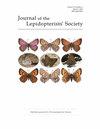印度凤尾蝶的领地及求偶行为
IF 0.3
4区 农林科学
Q4 ENTOMOLOGY
引用次数: 0
摘要
本文章由计算机程序翻译,如有差异,请以英文原文为准。
Territorial and Courtship Behaviour of Indian Common Crow Butterfly (Euploea core core)
ABSTRACT. The contest between conspecific males for mating opportunities is common among different species. Many species of butterfly defend a territory for the purpose of mating. In our study, the mating and courtship behaviour of the Indian common crow butterfly Euploea core core (Lepidoptera: Nymphalidae) was observed, which is a widely distributed native and important pollinator. Indian common crow butterfly defends a sunspot as territory for mating. When other butterflies come near or into the territory, a non-contact aerial interaction occurs between them. The owner of the territory excludes the intruders by chasing them out. Males of this butterfly species prefer a territory characterized by sunlight at the edge of woodland or open tracks in the forest containing host plants and oviposition sites near it. Indian common crow butterfly exhibits territorial activity throughout the day but is more frequent in the afternoon. The frequency of chasing for a longer duration is very low. The duration of chasing for the conspecific male is higher than that of heterospecific males. This is the first documentation about the territorial and courtship behaviour of Indian common crow butterflies. A new distribution record for the species has been reported as well. Such studies are essential not only to understand their behavioural patterns but also to understand their needs while planning conservation efforts.
求助全文
通过发布文献求助,成功后即可免费获取论文全文。
去求助
来源期刊

Journal of the Lepidopterists Society
ENTOMOLOGY-
CiteScore
0.70
自引率
0.00%
发文量
41
审稿时长
>12 weeks
期刊介绍:
The Journal of the Lepidopterists'' Society is a quarterly scientific publication of The Lepidopterists'' Society. It contains refereed scholarly papers on the behavior, biology, conservation, ecology, evolution, genetics, morphology, physiology, systematics, and taxonomy of moths and butterflies.
 求助内容:
求助内容: 应助结果提醒方式:
应助结果提醒方式:


